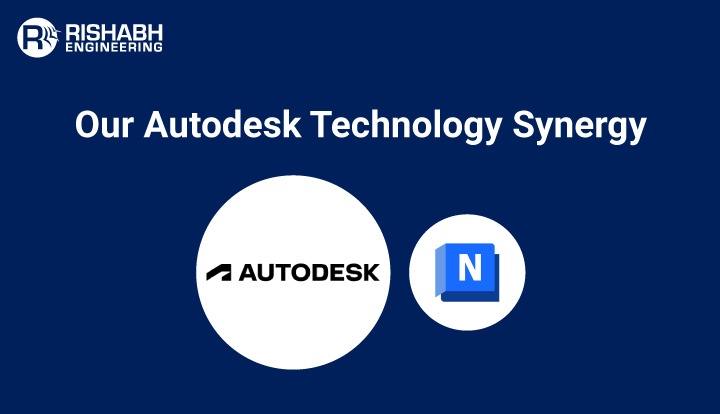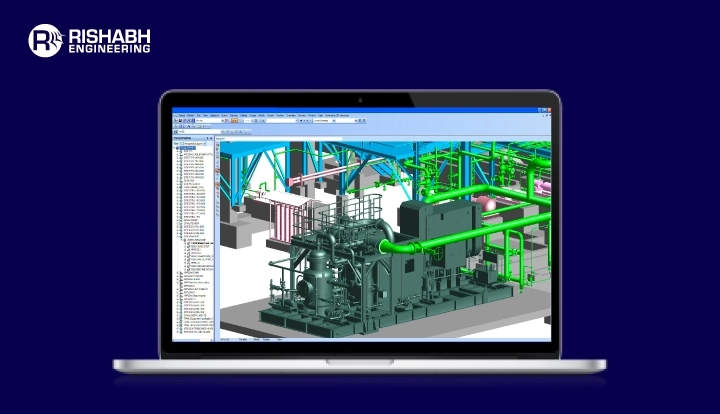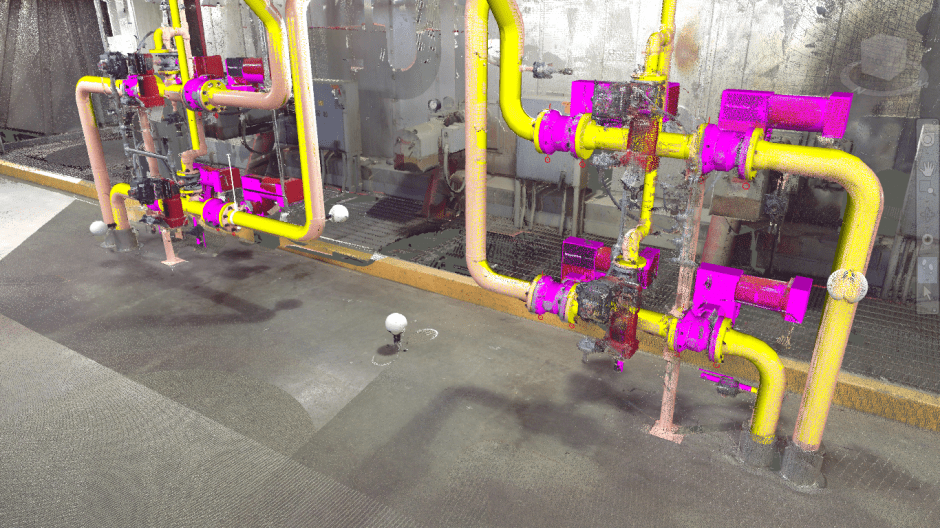
Utilizing Autodesk Navisworks For 3D Model Review
Navisworks is a powerful tool for piping design engineers, transforming how they work with 3D models. This software allows users to easily open, view, and combine 3D design models, offering a realistic look at plant layouts during the design phase. It enables engineers to navigate through virtual environments in real time, making it simple to coordinate, detect clashes, schedule projects, render images, and simulate construction.
This blog will explore how Rishabh Engineering utilizes Navisworks with its features, benefits and real-life use cases that make engineering projects more efficient and successful.

How Does the Rishabh Engineering Team Utilize Autodesk Navisworks?
Our team conducts 3D model reviews using Navisworks. It helps enhance project efficiency and accuracy across various engineering disciplines. Using Navisworks, we can combine complex 3D models while providing a comprehensive visual representation of plant designs. This allows our engineers to navigate through designs in real time, facilitating better understanding and communication among team members and clients.
Key applications of Navisworks for 3d model reviews include:
- Coordination: Integrating multiple design models ensures all systems work seamlessly.
- Clash Detection: Identifying and resolving conflicts between different systems early in the design process to avoid costly rework.
- Project Scheduling: This software allows linking 3D models with time-related data, improving project planning and management.
- Rendering is the process of creating high-quality visuals that assist stakeholders in understanding design intent and making educated decisions.
- Quantification: Accurately determining material quantities and costs to aid in exact project budgeting.
- Construction Simulation: The simulation of construction processes to predict and address any issues before they occur on-site.
Want to explore Rishabh Engineering’s Autodesk capabilities? Discover how we leverage Autodesk’s leading 3D modeling software to enhance engineering design through real-life examples.
About Navisworks – Introduction
Navisworks is a versatile software that compresses REVIT 3D model files to smaller, more manageable sizes, allowing various team members to access and interact on the platform. It excels at resolving disparities between different consultant models and functions as a powerful desktop tool for filtering and separating specialized model data. It is primarily utilized for project evaluation but can also open and integrate diverse 3D models to discover incompatibilities. Further, this software was originally developed by Lightwork Design and acquired by Autodesk in 2007, with the first stable release coming in 2016.
Key Features of Navisworks
- Model Integration and Review: Navisworks allows users to review 3d models using Navisworks while combining 3D models from various design software, including AutoCAD and Revit. This integration supports comprehensive model reviews, enabling teams to view and interact with complex designs in a unified environment.
- Clash Detection: Navisworks excels in clash detection, identifying conflicts within the model that could lead to issues during construction. The Multithread Clash Detection feature as part of the 3D model review in Navisworks significantly speeds up the detection process, ensuring faster and more efficient identification of potential problems.
- Quantification: This feature lets users extract and quantify elements from the federated model, transforming them into constructible items with associated materials and preliminary information. The resulting quantitative data can be exported to spreadsheets or integrated with estimating systems, facilitating precise cost management.
- Time Simulation (4D Simulation): Navisworks supports 4D simulations, allowing users to link model elements to project schedules. This enables visualization of construction sequences over time, helping teams plan and optimize construction processes.
- Interference Checking: Beyond clash detection, Navisworks can check for various interferences within the model, ensuring all elements fit together as intended and reducing the risk of costly on-site adjustments.
- Photorealistic Rendering: Using plugins, Navisworks can produce photorealistic renderings of models, aiding in visualization and presentation. This feature is valuable for stakeholder presentations and design validation.
- BIM 360 Integrations: This integration enables access to the latest project data and, thus, uninterrupted collaboration. The modified models in Navisworks are automatically saved and updated within BIM 360, ensuring all team members work with the most current information.
- Shared Views: The shared views feature in BIM 360 allows users to create and share specific views of the model. This functionality supports better collaboration by enabling team members to focus on particular aspects of the project and facilitate targeted discussions.
- Section Cutouts and Highlighting: The cut plane highlight feature allows users to visualize specific sections of the model clearly. This is particularly useful for addressing complex coordination issues and ensuring clear communication among project stakeholders.
- IFC and DGN File Readers: Navisworks supports reading IFC files, facilitating interoperability with various BIM standards. It also supports importing 3D DGN and PRP files from Bentley’s MicroStation, respecting referenced files and cell instances during selection.
- BIM Coordination: Navisworks enhances BIM coordination by integrating with BIM 360 Model Coordination. This integration supports clash detection and design review workflows, helping teams identify and resolve issues early in the project lifecycle.
- Change Analysis: This feature helps users track and analyze changes within the model, ensuring accurate quantity takeoffs and quickly identifying any additions or deletions. It enhances the ability to manage modifications and maintain project accuracy.
Benefits Of Navisworks
Listed below are some of the advantages of conducting 3D design reviews in Navisworks;
- Enhanced Coordination for Identifying Clashes: Navisworks facilitates the creation of “federated models,” where individual models are accurately placed within a common environment. This enhances project coordination and visualization, making identifying clashes within the 3D model easier. It supports over 60 file formats and integrates with software like AutoCAD®, Revit®, and ReCap®. Further, Navisworks simplifies file and data sharing, including clash reports, by breaking down larger files into smaller, more manageable versions without losing out on details.
- 3D Visualization to Resolve Clashes: 3D design review using Navisworks allows stakeholders to make material changes and update information in real-time, reducing interdisciplinary clashes. By visualizing project sections, users can quickly detect and analyze clashes faster than with other design software. Navisworks also offers advanced rendering for photorealistic 3D project walkthroughs, making it easier to spot clashes. The Navisworks Freedom tool enhances this by enabling model walkthroughs with spin, flip, and rotation capabilities, facilitating better interaction with the design team.
- Accurate Collision Detection: Navisworks provides robust collision detection, allowing users to filter through design elements quickly and set up collision tests between models and various components. Saved filters and searches streamline the process, ensuring consistency and efficiency in clash inspection and review.
- Reduced Errors Using the Clash Detective Tool: The Clash Detective tool in Navisworks identifies errors by conducting clash tests between 3D geometry and laser-scanned point clouds within specified tolerances. The engineering teams could utilize base softwares such as Tekla Structures or Revit to resolve the clashes identified. Navisworks’ clash detection tool can be integrated with other tools like Navisworks Manage and Navisworks Simulate for enhanced functionality.
- Detecting Time-Based Clashes in 4D Design Projects: Navisworks can link the Clash Detective tool with the TimeLiner to test for clashes involving moving objects in 4D design projects. This allows identifying the exact time when two elements or models will occupy the same space, detecting clashes in the time sequence. Automated time-based clash detection can be set up to run throughout the project’s lifecycle, enabling continuous review, rescheduling, and resolution of these clashes.
Real Life Use Cases – Navisworks
Case 1: Laser Scan to 3D Modeling of Topside FPSO Module
Project: FPSO Topside Module Laser Scan To 3D Modeling
Client: An American multinational energy corporation engaged in every oil and natural gas sector aspect.
Objective: Our client requested assistance with laser scan to 3D Modeling of the topside FPSO module. The project included various services, including FPSO topside process module design, laser scan verification, and 3D modeling. Rishabh Engineering embarked on a transformative mission that included site assessments, data collection, and building a dynamic 3D model of the FPSO topside modules. Their extensive approach also included structural analysis, equipment position planning, and the creation of MTOs and reports for piping, mechanical, civil, structural, electrical, and instrument disciplines, resulting in a smooth and integrated project execution.
Case 2: Piping Stress Analysis For Glycol Processing System
Project: Pipe Stress Analysis & support node number marking for the Glycol Piping System using CAESAR II
Client: EPC contractor
Objective: The Rishabh Engineering team performed a comprehensive piping stress analysis for the glycol processing system, incorporating support node number marking as required by the client. Rishabh Engineering successfully delivered the piping stress analysis within a span of three months. The project was executed by a dedicated team of three members, including one team leader, adhering to the ASME B31.3 codes and standards to ensure high-quality results.
Case 3: Pipe Stress Analysis & 3D Modeling of Pressure Vessels using CAESAR II
Project: 3D Modeling & Piping Stress Analysis of Pressure Vessels
Client: An engineering firm specializing in pressure vessels, piping components, structural design, CAD modeling, and manufacturing details.
Objective: Develop 3D models on CAESAR II and conduct stress analysis for an ongoing project. Rishabh Engineering was tasked with executing for the end customer – Pipe Stress Analysis & 3D Modeling of Pressure Vessels using CAESAR II. To avoid data loss during file extraction, the .CII file was extracted using CADWorx, as both CAESAR and CADWorx are owned by Hexagon. The process began with debugging the CAESAR model, fixing broken links, and ensuring that the boundary conditions matched the CADWorx model.
| Parameter | Value |
| Total Piping Systems | 5 |
| Total Number of Lines | 100 |
| Max. Pipe Diameter | 30” |
| Max. Temperature | 350° F |
| Max. Pressure | 350 psi |
Final Words
Finally, Navisworks improves the productivity and accuracy of engineering projects at Rishabh Engineering. Our 3D CAD modeling services team achieves seamless coordination and accurate execution by utilizing its advanced capabilities for 3D model integration, clash detection, project scheduling, and real-time navigation. When combined with real-world use cases, these features show Navisworks’ critical role in transforming complicated engineering ideas into successful, on-time project completions.
Seek help with 3D Model Reviews?
Our team utilizes Navisworks for 3D visualization, clash detection, and real-time navigation to enhance project efficiency.
Related Blogs
Related Blogs
Plant Reverse Engineering Services
What is Reverse Engineering? An engineering process implemented for enhancing…
Best 3D Plant Design Softwares for Multi-Disciplinary Engineering
In the modern context, the modeling and analysis of new-age…

